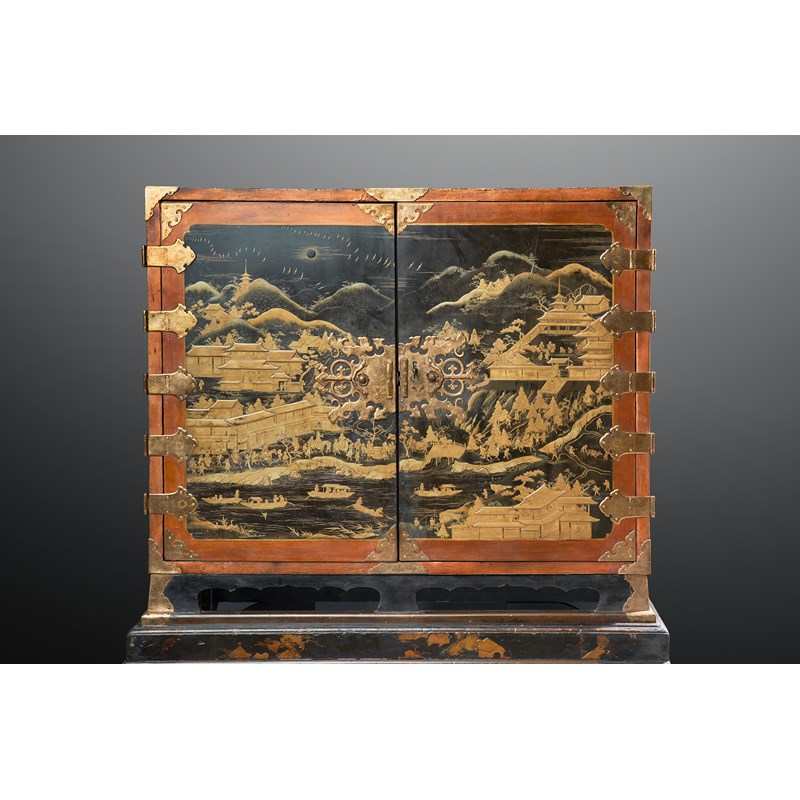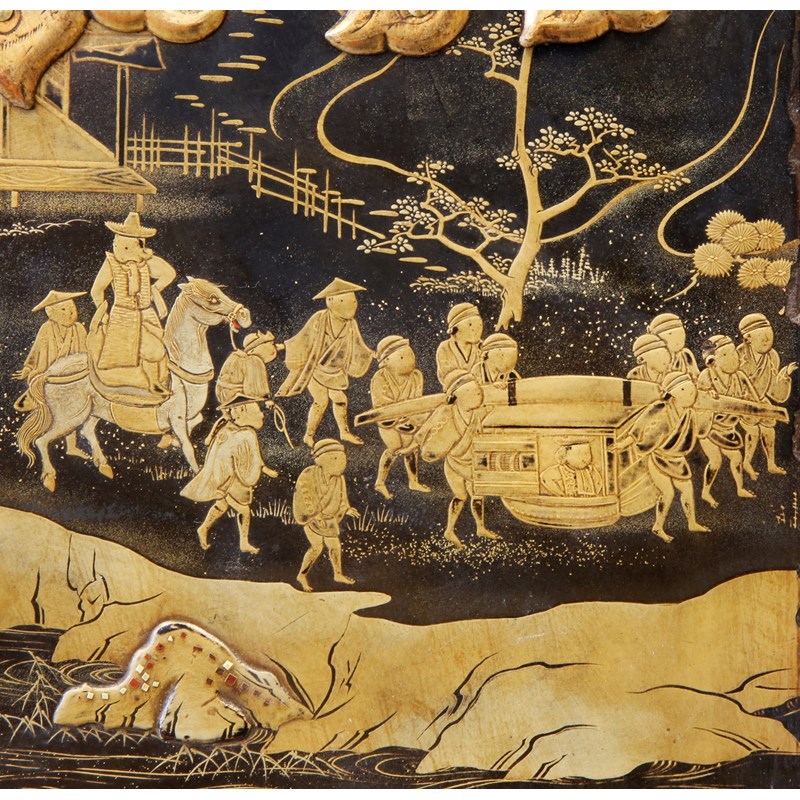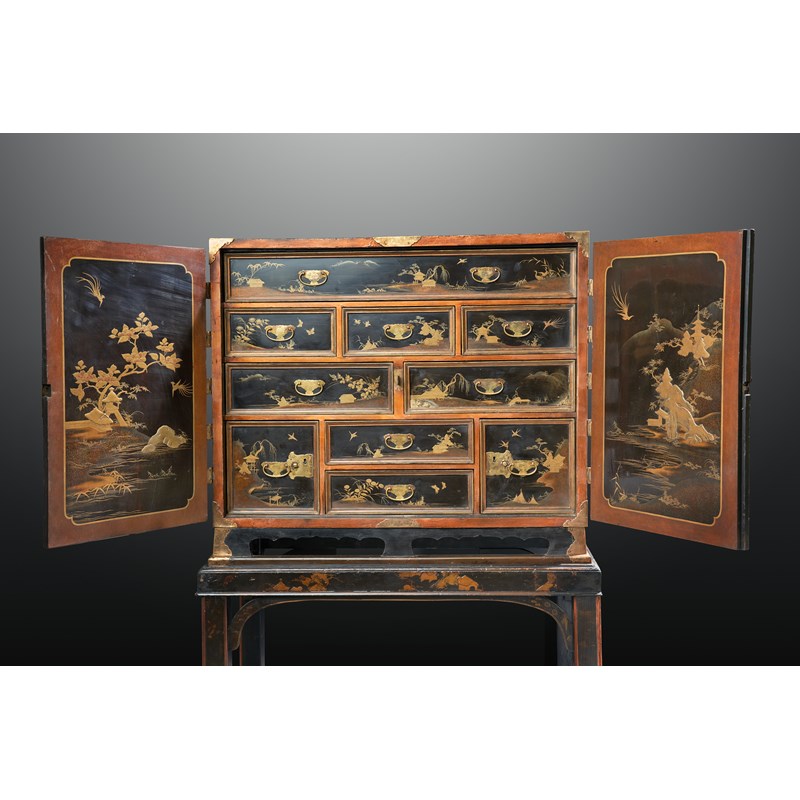Japanese Works of Art - 23 Nov 2021
A RARE AND IMPORTANT JAPANESE LACQUER CABINET FOR THE DUTCH MARKET
A RARE AND IMPORTANT JAPANESE LACQUER CABINET FOR THE DUTCH MARKET
EDO PERIOD, C.1680
Of rectangular form with a flat top, the sides and front embellished in gold, silver, brown and red lacquer hiramaki-e on a deep black roiro ground with a continuous design, the large panels depicting a complex scene of many figures in a mountainous river landscape; the left side with a rare depiction of the island of Dejima, a three-masted fluyt (cargo ship) sailing toward it, flying the tricolour flags of the Dutch East India Company and the stern with a small monogram reading VOC. The right-hand side of the panel depicts a busy street of Nagasaki leading to the Dutch island, with many figures in traditional garments engaged in daily life; a small wooden bridge leads to the fan-shaped artificial island, three Dutch men are visible outside the buildings and two Japanese figures sit in seiza in a small hut in the centre, probably guards. Japanese boats sail in the distance, and a four-storey pagoda with many birds flying above are visible behind. The front doors are decorated with a long procession, the many travellers on foot and on horseback, three of the horse riders dressed as Dutch merchants and a fourth figure, probably the Opperhoof (chief trader), is seen in a palanquin. Many Japanese figures on either side of the procession are engaged in various activities: some play musical instruments on board of small boats, others are fishing; figures inside buildings are depicted playing go, and farmers to the side are tending to their rice paddocks. The upper half of the right door depicts a large mansion, probably the local daimyo's castle, with men kneeling before another figure in the central courtyard. The right side of the cabinet is painted with further horse riders and their retinue journeying through mountains.
The pair of doors to the front open to reveal eight rectangular drawers and two further doors with escutcheons; the cabinet is decorated to the inside with scenes of many birds in flight in further mountainous river landscapes, the reverse of the left door with two thatched buildings, one with a ladder, underneath a camellia tree with large blooms; the right door with a three-storey pagoda nestled amongst trees; with some details rendered in raised takamaki-e; the cabinet with elaborately engraved metal clasps and lock plates, together with the original key, raised on a later European Japanned wood stand, the cabinet 88cm x 100.5cm x 54cm.
Provenance: an English private collection formerly at Cliff Avenue, Cromer, Norfolk since the 1950s and thence by descent. Believed by the family to have been purchased from Margaret Jane Barclay (1861-1958) of Herne Close, Cromer, together with the entire contents of her house. Margaret's ancestor James Barclay (1708-66) established the Barclays banking dynasty. It is likely that the cabinet was purchased by Margaret's father, Joseph Gurney Barclay (1816-98), who built Herne Close as a holiday house and furnished it. Joseph was one of the wealthiest members of the Barclays family, leaving many properties and a fortune of £900,000 to his children after his death.
LOT ESSAY:
The Dutch East India Company or VOC (Vereenigde Oostindische Compagnie) had an exceptional position in 17th century Japan. On 24th August 1609, Jacques Specx (the first chief merchant or Opperhoofd) was given the permission to trade by the Shogun, Tokugawa Ieyasu. After the Portuguese were expelled from the country, the Dutch became the only Europeans allowed to trade there. In 1634, the artificial fan-shaped island of Dejima became their trading post. The island was only 185 meters long and the VOC had to pay about £150,000 per year for it. There was only one bridge connecting it to the shore which gave local authorities complete control over the Westerners. There was a maximum of twenty Dutch people living on the island at any time, and -officially- none of them were soldiers or women.
Restrictions on Dejima were tight and the merchants were only allowed to leave the island by special permission. The Chief Opperhoofd could only stay on Dejima for a year, and each new one had to go to the capital of Edo to pay tribute to the Shogun and obtain permission to keep on trading. At first, they would travel with gifts once a year, but later this audience was only required once every four years. The procession (the Hofreis) would include the Opperhoofd (depicted here in a norimono palanquin), his secretary and his physician. The Dutchmen on this cabinet are easily recognisable, wearing Western outfits and wide-brimmed hats.
The Dutch travellers were treated like local daimyo lords, who also had to pay tribute to the Tokugawa leader and undertake regular trips to Edo under the sankin kōtai (alternate attendance) system. One can only imagine the spectacle this procession would have been for local people, and many are depicted here stepping out of their houses to observe the foreigners.
European collectors would have been familiar with some of the decorative elements often encountered on these lacquer pieces for export, including combinations of the ‘seven grasses of autumn’ and other blooms such as chrysanthemum, magnolia, and peonies.
The decoration with many figures engaged in daily activities is reminiscent of rakuchu rakugai zu (Scenes in and around the Capital), a style of paper screens decorated with bird’s eye views of the busy streets of the old capital of Kyoto. The Japanese figures here are depicted fishing, playing musical instruments on boats, tending to their fields, playing go, and paying tribute to the local lord.
Japanese lacquer cabinets such as lot 1046 were very expensive and as such, they were seen as a luxury item worthy of European courts. This cabinet is a good example of the type of export lacquer popular in the 17th century for its decoration of mountainous river landscapes. The shape is adapted from earlier Portuguese and Spanish escritórios or bargueños concealing many drawers of various sizes. Japanese lacquer was a luxury commodity, and it became even more sought-after when Japan restricted relations with the rest of the world after 1639. Some of the most prestigious commissions for these high-quality lacquer cabinets include Cardinal de Mazarin’s order for sixty coffers and cabinets in 1661, largely decorated with landscapes and figures. One of these magnificent coffers is now on display at the Victoria & Albert Museum, access. no.412:1, 2-1882.
The Dutch Royal Collections also include a pair of important Japanese lacquer cabinets with depictions of Dejima and the Chief merchant travelling to Edo for the Hofreis. These cabinets were possibly a gift to Amalia van Solms (1602-75), an avid Japanese art collector and lover of lacquerwares. Japanese cabinets depicting Dutch merchants would have been appropriate presents to the wife of the Stadtholder. This very expensive pair of cabinets were probably commissioned by the Company or by one of the VOC Chambers; however, there is no documentation recording the order.
The unusual depictions of the Opperhoofd and the Hofreis on lot 1046 suggest that the cabinet was also a special commission for Dutch nobility or a high-ranking VOC official serving in the Dutch East Indies.














 Live online bidding is available via our own
Live online bidding is available via our own